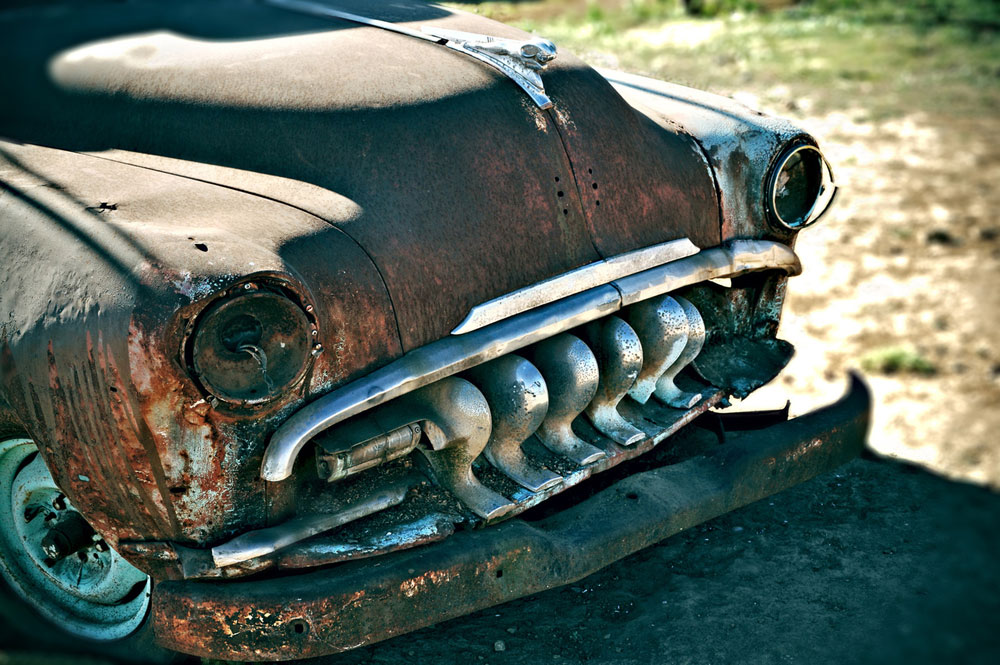There are several reasons why you may be concerned about rust spots on your car. If you are going to try to sell it, any appearance of surface rust will drive down the re-sale price considerably. If you plan on keeping the car for a long time, then you want one that looks nice and that won’t be falling apart around itself. If you have surface rust that has developed from a chip in the paint, or even rust that has started as the result of the broken paint surface over a dent, you can take a few steps that will have your car looking great again in no time. Just because your car is old doesn’t mean that it has to be a rust bucket. Prep the Rusted Area The first step, as with any other household paint job that you may be familiar with, is to properly prepare the surface to accept the paint. In the case of a car body, the purpose is two-fold. Not only are you preparing the metal to accept the paint, but you are also repairing it cosmetically by creating a perfectly shaped surface that is smooth and free of defects. The best way to begin preparing the surface is with an electric hand held grinder. Use a 150 grit sanding wheel to begin creating a smooth surface. There will be a definite drop off point where the paint has been chipped away. You want to use the sanding wheel to level that surface so that you can’t feel the difference between the painted surface and unpainted surfaces with your fingers. Try it with your eyes closed to see if you can really feel it or not. Use the sanding wheel to remove as much as the rust as possible, but don’t get frustrated if it wont take it all away. The next step will take care of that. The 150 grit wheel is good for preparing the area around the rust, but a metal grinding wheel is best for removing the actual rust itself. You need to be careful with this wheel because it can remove a lot of material quickly. Make sure you don’t overdo it, and work very slowly. This is an important step because, aside from removing the last of the rust, the metal grinding wheel will smooth out any pock marks or pits that the rust has left in the sheet metal. After you have removed as much rust as you safely can with the metal grinding wheel, then its time to move to hand sandpaper. I recommend 150 grit. This is going to be used to remove any last stubborn rust spots and to perfect the transition that you created between the painted edge and the bare metal. Take your time and do a great job here. This is the step where you will make or break the quality of your finish. If there is a dent, or some really deep pock marks left over from the rust that you just can’t grind out without damaging the sheet metal, you can use Bondo or another body filler to fill the gaps, dents, pits, and just about anything else. This product is available at most auto parts stores and includes detailed instructions for its use. The key to success here, as with the first steps, it to make sure that the final sanding passes are perfect. Prime and Paint Once you are completely satisfied with the surface preparation, begin taping the area off. I would recommend using the blue painter’s tape that is available at most home improvement stores, as it does not leave a sticky residue when removed. Begin with a high quality auto body primer. The key is to apply very thin coats instead of trying to use one very think one. Paint builds its strength by being applied in layers. Apply three thin coats of primer, waiting about 10 minutes between each one. After the third coat has been applied, let it sit overnight so the primer can fully cure. After the primer has been given a chance to completely dry, take a piece of 150 grit paper and very lightly hand sand the area. You are not trying to remove any paint, but are simply ensuring that the surface is smooth. Make sure you knock down any dust that may have accumulated in your primer coats while they dried. The paint, just like the primer, should be applied in very thin coats. You should usually use three coats, but you may find that four or more gives you a deeper looking finish. If you are able to match the color exactly, you may want to use more so the repaired area blends seamlessly. If you are not able to get a 100% color match, then a few coats should be sufficient, as you don’t want the area to jump out visually. As with the primer, let it dry between coats – I would recommend at least two hours between coats. The label on the product may also give you a good recommendation for dry time. After the final coat of paint has had the chance to cure overnight, give the entire car a good wash and wax to help blend the repaired area into the rest of the finish. Now it’s time to step back and admire your handy work. You repaired your own rust damage and, as long as you already owned a grinder, you didn’t spend more than $25.







